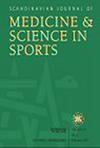The Association Between 24-h Physical Behavior Compositions and Persistent Musculoskeletal Pain.
IF 3.8
2区 医学
Q1 SPORT SCIENCES
引用次数: 0
Abstract
Individuals with musculoskeletal pain are generally advised to "be active", "reduce sedentary behavior", and "sleep enough", but such broad recommendations can be challenging to implement in daily life. We identified 24-h physical behavior compositions associated with musculoskeletal pain, using cross-sectional data from 817 participants in the Copenhagen City Heart Study. Daily durations of sedentary behavior, standing, light intensity, and moderate-to-vigorous physical activity during leisure and work, and time in bed were measured using thigh- and hip-worn accelerometers (24 h/day for 7 days) and were used as exposure. The outcome was persistent musculoskeletal pain (past 6 months, pain intensity or activity limitation: ≥ 3 on a 0-10 scale). We used logistic regression models to predict 24-h physical behavior compositions with the 15% lowest and highest probabilities of pain. Persistent musculoskeletal pain was reported by 40%. Individuals with a low and high probability of persistent musculoskeletal pain had distinct 24-h physical behavior compositions compared to the mean 24-h composition of the study population. Individuals with a low probability of pain had less leisure time sedentary behavior and time in bed but more sedentary behavior during work ("sweet spot" composition). Those with a high probability of pain had more leisure time sedentary behavior and time in bed but were less sedentary and more active during work ("sour spot" composition). In conclusion, these results can inform the development of actionable domain-specific 24-h physical behavior guidelines for individuals with musculoskeletal pain and aid in developing targeted interventions to improve musculoskeletal health, but we acknowledge the risk of reversed causality.24小时身体行为组成与持续性肌肉骨骼疼痛之间的关系。
患有肌肉骨骼疼痛的人通常被建议“积极活动”、“减少久坐行为”和“充足睡眠”,但这种广泛的建议在日常生活中很难实施。我们利用哥本哈根城市心脏研究中817名参与者的横断面数据,确定了与肌肉骨骼疼痛相关的24小时身体行为组成。使用大腿和臀部佩戴的加速度计(每天24小时,持续7天)测量休闲和工作期间久坐行为、站立、轻强度和中高强度体力活动的每日持续时间,以及卧床时间,并将其作为暴露。结果为持续的肌肉骨骼疼痛(过去6个月,疼痛强度或活动限制:≥3(0-10评分))。我们使用逻辑回归模型来预测24小时的身体行为构成,其中最低和最高疼痛概率分别为15%。40%的人报告有持续的肌肉骨骼疼痛。与研究人群的平均24小时组成相比,持续性肌肉骨骼疼痛的低概率和高概率个体具有不同的24小时身体行为组成。疼痛可能性较低的个体在闲暇时间久坐行为和卧床时间较少,但在工作期间久坐行为较多(“最佳点”构成)。那些很可能疼痛的人在闲暇时间久坐和卧床的时间更多,但在工作时久坐的时间更少,更活跃(“酸点”组成)。总之,这些结果可以为肌肉骨骼疼痛患者制定可操作的特定领域24小时身体行为指南提供信息,并有助于制定有针对性的干预措施以改善肌肉骨骼健康,但我们承认反向因果关系的风险。
本文章由计算机程序翻译,如有差异,请以英文原文为准。
求助全文
约1分钟内获得全文
求助全文
来源期刊
CiteScore
7.90
自引率
4.90%
发文量
162
审稿时长
3 months
期刊介绍:
The Scandinavian Journal of Medicine & Science in Sports is a multidisciplinary journal published 12 times per year under the auspices of the Scandinavian Foundation of Medicine and Science in Sports.
It aims to publish high quality and impactful articles in the fields of orthopaedics, rehabilitation and sports medicine, exercise physiology and biochemistry, biomechanics and motor control, health and disease relating to sport, exercise and physical activity, as well as on the social and behavioural aspects of sport and exercise.

 求助内容:
求助内容: 应助结果提醒方式:
应助结果提醒方式:


